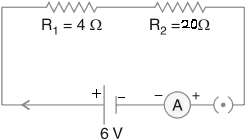Section C
Question: 6. (1). How chloride of chemically differs from calcium chloride? [3]
(2). What happens when chloride of lime reacts with sulphuric acid? Write chemical equation involved.
(3). Mention two used of chloride of lime.
Answer:
- Chloride of lime is calcium oxychloride (CaOCl2) while calcium chloride is CaOCl2.
- CaOCl2+ H2SO4 → CaSO4 + Cl2+ (g) + H2O
Cl2 (Chlorine) gas is evolved during this reaction. - (i). It is used for bleaching of wool and cotten in Textile industry.
(ii). For disinfecting of drinking water.
Or
Define acids. Explain two chemical properties of an acid and write chemical equation for one example of each property. [3]
Answer: Acids are compounds, which give H+ ions in their aqueous solutions.
Acids react with bases to form salt and water (Neutralisation reaction).
HCL + NaOH → NaCl + H2O
Dilute acids react with mentals to release H2 gas.
Zn + 2HCl(aq) → ZnCl2 + H2
Question: 7. Give reasons for the following: [3]
(1). Arteries are thick walled.
(2). Blood goes only once in once in one cycle through the heart in fishes.
(3). Plants have low energy needs.
Question: 8. For a receiving tennis player. Explain what the path from the stimulus to the response is. [3]
Message to Brain
↑
Seeing (By eyes) → Sensory Neuron → Spinal Cord
↓
Action (Response) ← Muscles of Arm ← Motor Neuron ← Relay Neuron
Question: 9. In the given circuit, calculate: [3]
(1). the total resistance of the circuit,
(2). the current through the circuit, and
(3). the potential differences across R1 and R2

Answer:
- Total R = 4 + 20 = 24 Ω;
- I = v / R = 0.25 A
- V1 = 4 × 0.25 ⇒ V of R1 = 1 Volt
- V2 = 20 × 0.25 ⇒ V of R2 = 5 Volts.
Question: 10. Write the sign conventions for spherical mirrors. [3]
Answer: Sign conventions for spherical mirrors:
- All the distances are measured from the ‘P’ (pole) of the mirror.
- Distances measured in the direction of incident ray are taken as positive.
- Distances measured opposite to the direction of incident ray are taken as negative.
- Distances measured perpendicular to and above the Principal axis are taken as positive.
- Distances measured perpendicular to and below Principal axis are taken as negative.
 Class Notes NCERT Solutions for CBSE Students
Class Notes NCERT Solutions for CBSE Students





